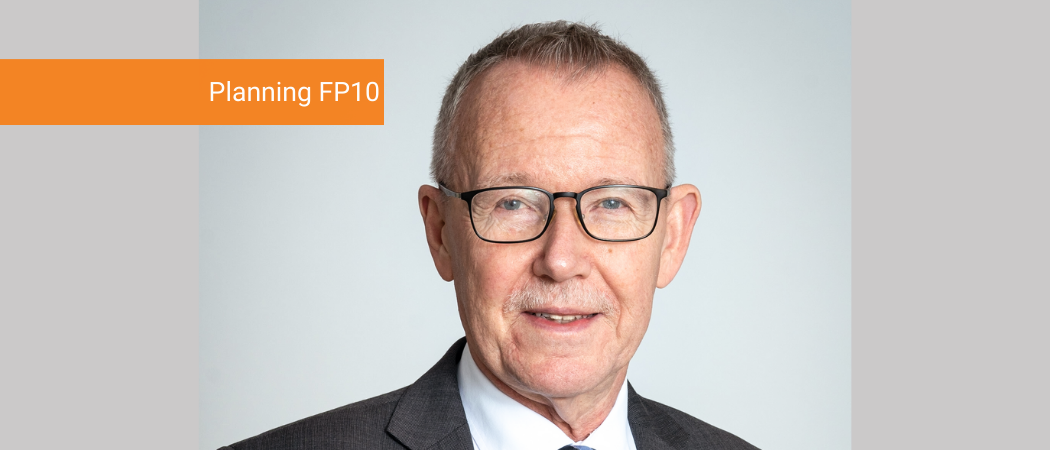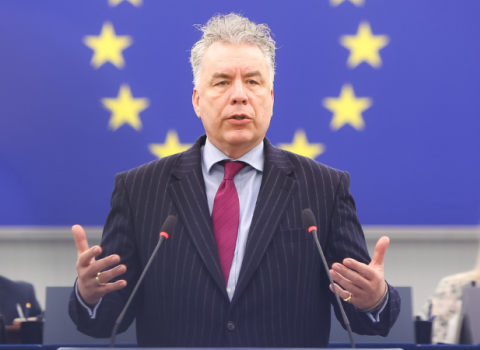Over 40 years, the EU’s flagship research programmes have drifted from their early focus on collaborative, pre-competitive R&D benefiting industry and society. A Swedish expert on the programme calls for a rethink

Dan Andrée represents the University Alliance Stockholm Trio in Brussels and is a senior fellow at the Centre Condorcet and the independent High Level Groups on EU Policy Innovation
Editor’s note: This viewpoint is part of a series Science|Business is publishing on the Framework Programme’s past and future – in the run-up to our celebration 12-13 February of the first Framework in 1984.
Once again – for the 10th time in 40 years – the European Union is planning a big Framework Programme to fund research and innovation. As a follower of the programme’s evolution since its start in the early 1980s, I have seen changes for good – and not-so-good.
Good has been the programme’s broadening to include curiosity-driven research in the European Research Council, and an emphasis on innovation and impact in society in the European Innovation Council and its focus on start-ups and small companies. However, in the present Framework Programme, called Horizon Europe, this shift has been at the expense of a cornerstone of Framework history and policy: to support collaborative research and technological development (RTD), as the foundation to stimulate innovation.
In my view, it is time to redress this. We must substantially increase the budget for the coming programme, Framework Programme 10. We must fully capture the available potential in Europe and globally. And we must increase collaborative research and technological development, along with interdisciplinarity, so we can better understand and address complex societal challenges.
When in London…
To understand why I say this, a bit of personal history may help. In February 1983 I took up the position as science counsellor at the Swedish Embassy in London. I had just finished a research career at the Royal Institute of Technology (KTH) in Stockholm, and a position as systems engineer at Sweden’s leading telecoms company, Ericsson.
In London, I saw great interest – at that pre-Brexit time – in the EU and its first Framework Programme, FP1. Because Sweden wasn’t yet an EU member, our own institutions had limited possibilities to take part – but it wasn’t impossible. I applied to attend the first FP conference in Brussels in September 1983 but was denied entry under my Swedish title. So I applied again with my UK-resident identification and was accepted. It was an eye opener.
When I returned to Stockholm in 1987, I was appointed director of the Swedish National IT programme and took the initiative to fund Swedish participation in what was then the two biggest FP cooperative R&D efforts, RACE for telecoms and ESPRIT for information technology. This helped Ericsson, Volvo and Saab cooperate with competitors in Europe on pre-competitive research.
The ‘pre-competitive era’
To understand the Framework Programme’s evolution, let’s start with the legal texts. Since the Single European Act in 1987, the FP goal has been clear:
The Union shall have the objective of strengthening its scientific and technological bases of European industry and encourage it to become more competitive at international level. In order to achieve this, it shall encourage enterprises including SMEs, research centres and universities in their research and technological development activities, it shall support their efforts to cooperate with one another.
This is what was called the “pre-competitive” era: companies competing on the market could cooperate with academia before product development to avoid unnecessary duplication, provide European added-value and contribute to tackling societal challenges.
According to a 2008 assessment, the RACE programme over the years had a positive impact on the competitiveness of the European telecommunications sector, as it helped to create common standards, foster innovation, and stimulate market demand for new services. Specifically for Sweden, the industrial benefits were clear:
- Ericsson’s participations enabled it to build strong positions in 3G mobile technologies through influencing standards and key choices of technological direction
- Sweden had already established significant industrial power in mobile technologies, but the FPs were a powerful lever on national industrial and technological competitiveness
- In the automotive industry, the Framework Programme’s role has been to sustain longer term R&D in areas such as fuel efficiency, emissions and safety that create not only private advantages for the industry but significant public goods
- FP money has been one of the factors enabling the industry in general, and for example. Volvo, to maintain a high level of technological capabilities
Again, this list shows the value of collaborative, public-private, precompetitive research. The European Commission’s Joint Research Centre has estimated that in the early FPs, every €1 in funding led to an increase in industry added-value of between €7 and €14.
The rise of ‘innovation’
One big change in the Framework Programmes as the years went by was a growing emphasis on supporting “innovation.” The Framework Programme objectives were amended in the EU’s Lisbon Treaty in 2007. But “innovation” isn’t specifically mentioned in the relevant article: the actual wording is “research, technological development and demonstration.” Instead, support for innovation was justified legally by other Treaty wording to promote “all the research activities deemed necessary by virtue of other Chapters of the Treaties.”
The resulting, gradual policy shift can be tracked in the wording of the successive Framework regulations authorising each programme. “Innovation” first appeared – 34 times - in the regulation for Framework Programme 7, which ran from 2007 to 2013. But the real “breakthrough” for innovation was in Horizon 2020, from 2014 to 2020, where it was mentioned 463 times. At the same time, “research and technological development” went down from seven mentions in FP7 to twice in Horizon 2020 and not mentioned at all in the current regulation, for Horizon Europe. It is true that many public-private partnerships have been set up in Horizon in different industrial technology areas, but they too exemplify a shift in emphasis toward innovation and impact.
Another big change was in FP7, introducing the European Research Council to fund frontier research. It was a shift from what had been a “holy” requirement that Framework projects include participants from several EU countries, to an aim of increasing excellence in research through competition at European level. Another positive development is the opening of Framework to the world, with many non-EU countries now participating.
In citing these facts, I am not arguing against the importance of innovation or frontier research – far from it. But I am saying that something else, pre-competitive collaborative research, has been losing emphasis. We see this in the successive FP calls for grant proposals: In Horizon Europe, the technology readiness levels (TRL – a standardised measure from 1 to 9, from basic research to full commercial deployment) have risen. Calls for lower, pre-competitive collaborative research have partly been replaced by closer-to-market, innovation-focused projects. (In more detail: 20% was the share of calls for early-stage projects, TRL 1-4, during the first two years of Horizon 2020, while the corresponding share for Horizon Europe was 14%, according to a joint statement earlier this year by CESAER and the European Universities Association.)
From the foregoing, I offer three recommendations to those now drafting FP10:
- Focus on collaborative RTD projects
All these factors – the focus on innovation, higher TRLs and limited budget – mean that we miss out on the pre-competitive collaboration which lays the ground for innovations at later stages. It is not only universities that are worried about these developments, but also large companies such as in telecommunication, transport and aeronautics. Of course, higher TRL projects are also important to customers of large companies and other users – but they should not be funded at the expense of pre-competitive collaboration.
- Substantially increase the budget
The scope of the Framework Programme has been broadened significantly over the years to emphasise impact, innovation, the new European Innovation Council with its focus on start-ups and SMEs, and research “missions” in soil, cancer and other fields important to policy makers. But all of this is without any real increase in budget; each new policy imperative drains money from older priorities, including pre-competitive collaboration. There is an urgent need to substantially increase the budget for the coming programme to fully capture available potential in Europe and globally so as to create new knowledge and solutions for current and future challenges. Further, this needed Framework budget increase should come from other programmes, in policy areas the FP supports, rather than directly from the FP budget itself. After all, a total increase of the EU budget is difficult to foresee.
- Increase collaborative RTD and interdisciplinarity to understand and address complex future challenges
The move towards higher TRLs has been at the expense of collaborative research and technological development projects that industry needs. Research Actions, a type of Framework project, for pre-competitive collaborative research at lower TRLs should be introduced in FP10 alongside existing project types. Research Actions will complement the bottom-up European Research Council with more top-down calls in important areas like health, climate and industrial technologies. In parallel we should strengthen the interdisciplinary perspective and better integrate the social sciences and humanities to help solve societal challenges. Calls should be as open in scope as possible (a non-prescriptive approach) to capture researchers’ and other actors’ creativity in defining and searching for solutions. The lower TRL will also facilitate cooperation with countries outside Europe, as earlier-stage projects pose fewer risks of disputes over intellectual property.
Dan Andrée has been based in Brussels since 1997 working for the Swedish Ministry of Education and Research, the European Commission (DG RTD) and Swedish Innovation agency Vinnova. He now represents the University Alliance Stockholm Trio (Karolinska Institutet, KTH Royal Institute of Technology, Stockholm University) in Brussels and is a senior fellow at the Centre Condorcet and the independent High Level Groups on EU Policy Innovation.





 A unique international forum for public research organisations and companies to connect their external engagement with strategic interests around their R&D system.
A unique international forum for public research organisations and companies to connect their external engagement with strategic interests around their R&D system.